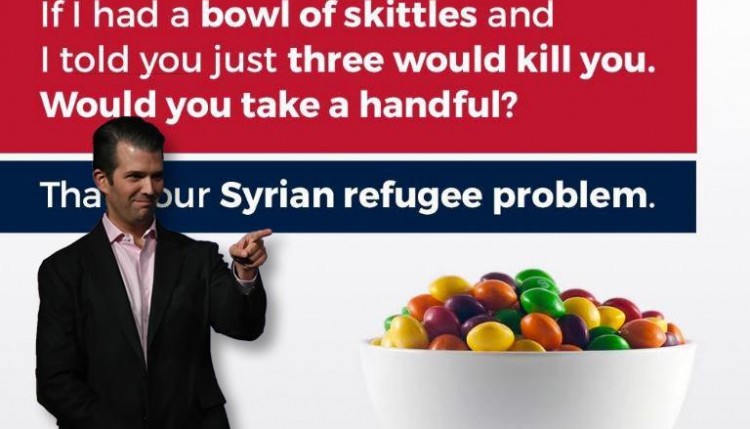
How many skittles would it take
We’ve studied different types of moral panics and looked at the effects they have. However, have we realized the fact that we are constantly living in a state of moral panic at the threat of terrorism? I have yet to experience an advertisement or an infographic on the percent of radical terrorists that act, and yet people were quick to believe the twitter post by Donald Trump’s son that refers to the Syrian refugees (pictured above). When I thought about the topics discussed in Disciplining Terror, I realized that I was a firm believer in the idea of “new terrorism,” where the main threats are “Islamic terrorism, right wing terrorism, small wars, and weapons of mass destruction.” (Stampnitzky, 140)
That was when I started to question how much of the beliefs I thought were a given are actually a result of a moral panic that started in the 1990’s. A majority of people believe that “Islam [is] an inherently violent and aggressive tradition” and frame Islam as the “new number one national enemy.” (Stampnitzky, 141) The signs that this is a moral panic are evident. There was widespread concern for “new terrorism” in 1993 after the World Trade Center was bombed, but more specifically Islamic radicalism after the increase in suicide bombings. There was also a consensus from “experts” in the field that “Islam was by nature anti-democratic, anti-Semitic and anti-Western.” (Pipes, “There Are No Moderates) However, people’s fear was disproportionally aimed towards Islamic radicals, when in reality there is also the idea of “right-wing terrorism” which can be home grown and just as prevalent a threat as Islamic terrorism (which is seen in the 1995 Oklahoma City bombing). Finally, we have approached the threat of terrorism in a volatile way, including “a new emphasis on precautionary techniques… which is focused outward upon the “enemy” aiming to prevent terrorist attacks before they happen.” (Stampnitzky, 163)
We know these effects are long lasting by looking at how people think about terrorism today. Trump’s son has automatically labelled a large influx of refugees from the Middle East as potential threats. Is this based on a widespread belief in “new terrorism”? Is this belief completely valid because the horrors outweigh the percent of people that would commit these acts of terror?